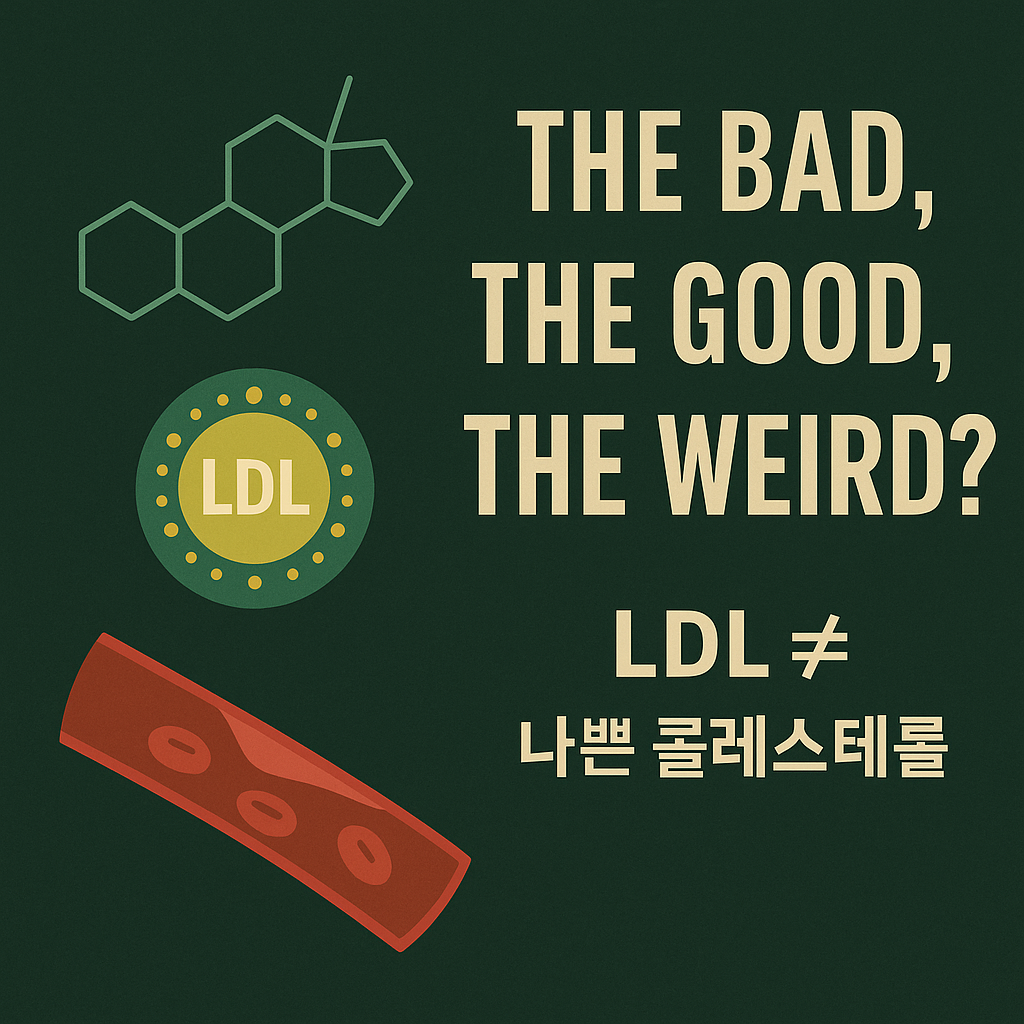이 글은 9편: 트라이글리세라이드의 이름을 되찾아야 하는 이유에 이어지는 글입니다.
콜레스테롤: 좋고 나쁨의 이분법은 없다 (그리고 왜 그 오해가 위험한가)
우리 몸에서 만들어지는 물질이나 분자 중, 항상 ‘나쁘기만 한 것’이나 ‘좋기만 한 것’은 없습니다. 생체 내 모든 요소는 복잡한 균형 속에서 각자의 역할을 수행합니다. 따라서 ‘나쁜 콜레스테롤’, ‘좋은 콜레스테롤’이라는 이분법적 표현은 오히려 중요한 사실을 왜곡합니다.
이러한 단순화된 용어는 트라이글리세라이드와 중성지방의 오역처럼, 대중의 건강 문해력에 혼란을 주고 실제로는 질병 위험을 높이는 잘못된 판단을 유도할 수 있습니다.
지방의 소화와 대사 과정: 콜레스테롤은 어떻게 이동하는가
지방은 주로 소장에서 소화되며, 담즙이 유화 작용을 통해 지방을 미셀로 전환시킨 후, 리파아제 효소가 지방산과 모노글리세라이드로 분해합니다. 이후 소장 세포에서 재합성된 트라이글리세라이드는 카일로마이크론으로 포장되어 림프계를 통해 심장을 거쳐 전신에 퍼집니다. 여기에 포함된 콜레스테롤 역시 전신 조직에 운반됩니다.
LDL은 정말 ‘나쁜 놈’일까?
LDL은 간에서 합성된 콜레스테롤을 말초 조직으로 운반하는 수송체입니다. 세포막 형성, 호르몬 합성 등에 필수적인 성분이며, 산화된 LDL은 면역 시스템과 상호작용하며 초기 면역 반응에도 관여합니다.
LDL 자체는 ‘나쁜’ 것이 아닙니다. 다만, 과잉되거나 변형될 경우 동맥경화를 유발할 수 있어 오해를 받아온 것입니다. 이는 “기능적 역할”과 “병리적 결과”를 구분하지 못한 데서 비롯된 오용입니다. [Mahley & Innerarity, 2003]
LDL과 LDL-C의 차이: 당신이 아는 수치는 무엇인가?
건강검진에서 흔히 확인하는 LDL-C 수치는 LDL이라는 입자의 콜레스테롤 함량을 간접적으로 추정하여 계산한 수치입니다. 실제 LDL 입자 수, 크기, 조성은 고려하지 않습니다.
LDL-C = 총콜레스테롤 – HDL-C – (TG / 5)
이 공식(Friedewald formula)은 간편하지만 정확도에는 한계가 있습니다. 특히 TG 수치가 높거나 낮은 경우, 당뇨병 환자, 대사증후군 환자에서는 오차가 커집니다. [Martin et al., JAMA, 2013]
대안은 무엇인가?
Martin-Hopkins 공식은 TG와 HDL 수준에 따라 보정계수를 적용하여 LDL-C를 좀 더 정확히 계산합니다. 그러나 이 역시 ‘간접적으로 계산된 추정 수치’에 불과하며, LDL 입자 수(Particle Number, ApoB)나 분획 크기 분석(NMR lipid profile)이 더 정밀한 진단에 유리합니다. [[Otvos et al., Atherosclerosis, 2002]]
이상한 놈: 50년 된 공식을 아직도 쓰는 현실
이제껏 한 번도 의사에게 LDL-C가 어떤 기준으로 추정되고 계산되는지 설명받은 적이 없었다면, 그것이 바로 문제입니다. LDL-C 수치 하나만으로 고지혈증을 진단하고 약물(스타틴)을 처방받는 현실은, 1970년대의 기술과 경제성 기준이 2025년까지 그대로 이어지고 있는 참으로 ‘이상한 현상’입니다.
다음 이야기 예고
다음 편에서는 **트라이글리세라이드 수치가 높아지는 진짜 원인**에 대해 알아보겠습니다. 단순히 ‘기름진 음식’만을 탓하는 설명을 넘어서, 우리가 간과해온 대사 시스템의 오작동을 깊이 들여다보겠습니다.
English Version
The Good, the Bad, and the Ugly? Misconceptions and Truths About Cholesterol Levels
This article is a continuation of Part 9: Why We Must Reclaim the Name of Triglycerides.
Cholesterol: There Is No Such Thing as “Good” or “Bad” (And Why This Misconception Is Dangerous)
There’s nothing in our body, no substance or molecule, that’s inherently “always bad” or “always good.” Every element within our biological system performs its role in a complex balance. However, simplistic, dichotomous terms like “bad cholesterol” and “good cholesterol” unfortunately distort crucial truths.
Such oversimplified terminology, much like the mistranslation of “triglyceride” to “neutral fat,” can confuse public health literacy and, in reality, lead to misguided decisions that increase the risk of disease.
Digestion and Metabolism of Fats: How Cholesterol Moves Through Your Body
Fats are primarily digested in the small intestine. Bile emulsifies fats, converting them into micelles, after which lipase enzymes break them down into fatty acids and monoglycerides. Subsequently, these re-synthesized triglycerides are packaged into chylomicrons within the small intestinal cells. These chylomicrons then travel through the lymphatic system, pass through the heart, and spread throughout the entire body. The cholesterol contained within them is also transported to various bodily tissues.
Is LDL Really “The Bad Guy”?
LDL is a transporter that carries cholesterol synthesized in the liver to peripheral tissues. It’s an essential component for cell membrane formation and hormone synthesis, and oxidized LDL interacts with the immune system, participating in early immune responses. [Mahley & Innerarity, 2003]
LDL itself isn’t inherently “bad.” It has simply been misunderstood because, when excessive or modified, it can contribute to atherosclerosis. This misuse stems from a failure to distinguish between its “functional role” and “pathological consequences.”
The Difference Between LDL and LDL-C: What Does Your Cholesterol Number Actually Mean?
The LDL-C level commonly checked in health screenings is an indirectly calculated value representing the cholesterol content within the LDL particle. It doesn’t take into account the actual number, size, or composition of LDL particles.
The formula: LDL-C = Total Cholesterol – HDL-C – (TG / 5)
While this formula (Friedewald formula) is convenient, it has limitations in accuracy. Errors can be significant, especially when TG levels are high or low, or in patients with diabetes or metabolic syndrome. [Martin et al., JAMA, 2013]
What Are the Alternatives?
The Martin-Hopkins formula applies a correction factor based on TG and HDL levels to calculate LDL-C more accurately. However, this is still merely a ‘calculated value.’ More precise diagnoses are better served by measuring LDL particle number (ApoB) or fractionated size analysis (NMR lipid profile). [Otvos et al., Atherosclerosis, 2002]
The Ugly Truth: Still Using a 50-Year-Old Formula?
If you’ve never had a doctor explain how your LDL-C is calculated and diagnosed, that’s precisely the problem. The reality of diagnosing hyperlipidemia and prescribing medication (statins) based solely on an LDL-C number, derived from 1970s technology and economic considerations, is truly ‘ugly’ – an anomalous practice that continues into 2025.
What’s Next?
In the next installment, we’ll explore the real reasons why triglyceride levels rise. Moving beyond simply blaming “fatty foods,” we’ll delve deeper into the metabolic system dysfunctions that we’ve often overlooked.
Japanese Version
悪玉、善玉、奇妙なやつ?コレステロール値に関する誤解と真実
この記事は「第9部:トリグリセリドの名前を取り戻すべき理由」に続く内容です。
コレステロール:善悪の二分法はない(そしてその誤解がなぜ危険なのか)
私たちの体内で生成される物質や分子の中に、常に「悪いもの」だけ、あるいは「良いもの」だけというものは存在しません。生体内のすべての要素は複雑なバランスの中でそれぞれの役割を果たしています。しかし、「悪玉コレステロール」「善玉コレステロール」という二分法の表現は、かえって重要な事実を歪めています。
このような単純化された用語は、トリグリセリドと中性脂肪の誤訳と同様に、一般の人々の健康リテラシーに混乱をもたらし、実際には病気のリスクを高める誤った判断を誘導する可能性があります。
脂肪の消化と代謝のプロセス:コレステロールはどのように移動するか
脂肪は主に小腸で消化され、胆汁が乳化作用を通じて脂肪をミセルに変換した後、リパーゼ酵素が脂肪酸とモノグリセリドに分解します。その後、小腸細胞で再合成されたトリグリセリドはカイロミクロンとして包装され、リンパ系を介して心臓を経由し、全身に拡散します。これに含まれるコレステロールも全身の組織に運ばれます。
LDLは本当に「悪者」なのか?
LDLは、肝臓で合成されたコレステロールを末梢組織に運搬する輸送体です。細胞膜の形成、ホルモン合成などに不可欠な成分であり、酸化されたLDLは免疫システムと相互作用し、初期の免疫反応にも関与しています。[Mahley & Innerarity, 2003]
LDLそのものは本質的に「悪い」ものではありません。ただ、過剰になったり変性したりすると動脈硬化を引き起こす可能性があるため、誤解されてきたのです。これは「機能的役割」と「病理的結果」を区別できなかったことに起因する誤用です。
LDLとLDL-Cの違い:あなたが知っている数値は何を意味するのか?
健康診断で一般的に確認されるLDL-C値は、LDLという粒子のコレステロール含有量を間接的に算出した数値です。実際のLDL粒子数、サイズ、組成は考慮されていません。
計算式:LDL-C = 総コレステロール – HDL-C – (TG / 5)
この公式(フリーデワルト公式)は簡便ですが、精度には限界があります。特にTG値が高い場合や低い場合、糖尿病患者、メタボリックシンドローム患者では誤差が大きくなります。[Martin et al., JAMA, 2013]
代替案は何か?
マーティン-ホプキンス公式は、TGとHDLレベルに基づいて補正係数を適用することで、LDL-Cをより正確に算出します。しかし、これも「算出された数値」に過ぎず、**LDL粒子数(Particle Number, ApoB)や分画サイズ分析(NMR lipid profile)**の方がより精密な診断には有利です。[Otvos et al., Atherosclerosis, 2002]
奇妙な現実:50年前の公式を今も使い続けている
もしあなたがこれまで一度も医師からLDL-Cがどのような基準で計算され診断されるのか説明を受けたことがないのなら、それこそが問題です。LDL-Cの数値一つだけで高脂血症を診断し、薬剤(スタチン)を処方される現実は、1970年代の技術と経済性を基準にした「奇妙な出来事」が2025年までそのまま続いていることを意味します。
次回の予告
次回は、トリグリセリド値が上昇する本当の原因について掘り下げていきます。単に「脂っこい食べ物」だけを非難する説明を超えて、私たちがこれまで見過ごしてきた代謝システムの誤作動を深く探求していきます。

Leave a Reply